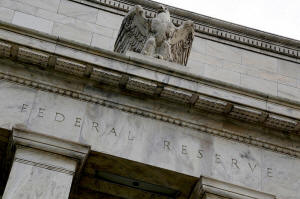Sticky inflation could be a wild card for easing timetable at Fed
meeting
 Send a link to a friend
Send a link to a friend
 [March 18, 2024] By
Karen Brettell [March 18, 2024] By
Karen Brettell
NEW YORK (Reuters) - The U.S. Federal Reserve is widely expected to keep
rates unchanged when it ends its two-day meeting on Wednesday, but
policy makers could show more concern about stubborn inflation and
present more hawkish signals about the timing and extent of any easing
this year.
Stronger-than-expected economic growth and stickier inflation this year
has led investors to push back expectations on the U.S. central bank's
first rate cut to June, from May, and reduce bets on how many cuts are
likely this year.
Traders are now pricing in three 25 basis points cuts, in line with Fed
policymakers' median expectations made in December. The Fed is due to
give updated economic projections and refresh its "dot plot" graphing
policymakers' interest rate projections at the meeting.
"What will be really interesting to see is if the Fed is still
comfortable in the dot plots to still be showing the possibility of
three rate cuts for this year," said Matt Eagan, head of the full
direction team at Loomis, Sayles & Co. "Or will they start to say we've
got to push back against this a little bit longer."
The Fed pivoted to a more dovish outlook in December on growing
confidence that inflation was on track to its 2% annual target.
Inflation has since picked up, though analysts note that recent
hotter-than-expected consumer and producer price index reports likely
reflected seasonal factors.

Powell said after the Fed's January meeting that the central bank wants
more confidence that inflation will continue to decline before cutting
rates.
"The Fed doesn't want to break anything," said Padhraic Garvey, regional
head of research, Americas at ING, adding that when inflation gets
closer to 2% the Fed will likely "use that opportunity as one to get
rates off the highs."
In the meantime, the Fed may caution about the prospect of near-term
rate cuts.
"The main focus is which way they lean," said Stephen Gola, head of U.S.
Treasuries Sales & Trading at StoneX Group.
An unexpected uptick in unemployment last month could keep the Fed
circumspect on growth, offsetting some of the inflation concerns.
Another possibility is that Powell could adopt a more hawkish tone by
referencing loose financial conditions as stock markets hit records and
corporate credit draws enthusiastic demand.
[to top of second column] |

An eagle tops the U.S. Federal Reserve building's facade in
Washington, July 31, 2013. REUTERS/Jonathan Ernst/File Photo

"He didn't say it (in January) but stocks have only gone higher and
I think they're going to struggle to achieve what they want to
achieve as long as that's the case," Gola said.
Powell in November cited financial conditions when higher Treasury
bond yields, mortgage rates and other financing costs were having a
tightening impact on the economy. His comments were interpreted as
potentially leading the Fed to hike rates less than expected.
HOW MUCH MORE QT?
The Fed may also signal that it is getting closer to tapering its
quantitative tightening (QT) program, in which it allows bonds to
roll off its balance sheet without replacement.
QT is meant to remove excess liquidity created by record bond
purchases designed to stimulate the economy during COVID-related
business shutdowns. So far QT has helped shrink the Fed's balance
sheet to $7.5 trillion from a peak of around $9 trillion.
With ample liquidity remaining in the market, Garvey said there is
no urgency to address the issue.
"In our calculations we've still got about $1 trillion worth of
excess liquidity in the system," Garvey said. "If I saw the Fed
getting concerned about taking liquidity away too fast it would lead
me to get a bit concerned that they've seen something that we're not
seeing in the system."
The Fed may also expand on Fed Governor Christopher Waller's
comments that it may look to shift its mix of purchases to hold more
shorter-dated Treasuries instead of mortgage-backed debt.
"Longer maturities have a bigger effect on the market," said Eagan.
By reducing duration but still buying Treasuries, they can
potentially decrease the market impact "without upsetting the
plumbing of the liquidity within the banking system," he said.
(Reporting by Karen Brettell; Editing by Alden Bentley and Richard
Chang)
[© 2024 Thomson Reuters. All rights
reserved.]
This material may not be published,
broadcast, rewritten or redistributed.
Thompson Reuters is solely responsible for this content.
 |